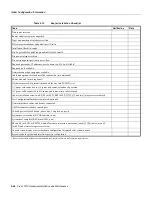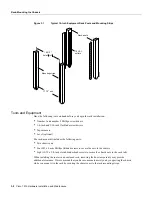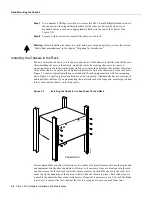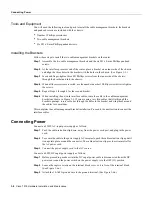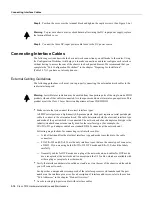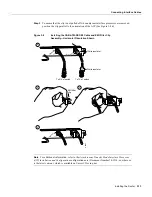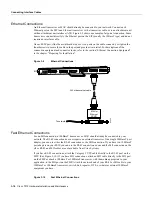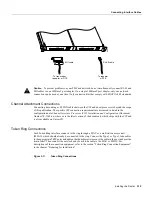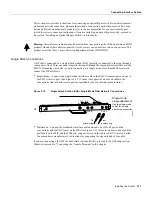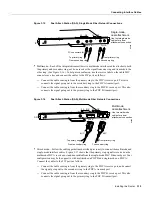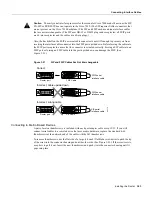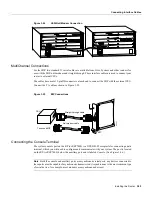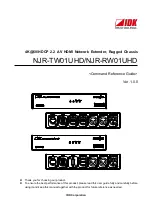
3-10 Cisco 7010 Hardware Installation and Maintenance
Connecting Interface Cables
Step 8
Position the cover over the terminal block and tighten the captive screws. (See Figure 3-6a.)
Warning
To prevent a short-circuit or shock hazard after wiring the DC-input power supply, replace
the terminal block cover.
Step 9
Connect the three DC-input power cable leads to the DC power source.
Connecting Interface Cables
The following sections describe the basic network connections you will make to the router. Using
the Configuration Worksheet will help you to make connections and later configure each interface
without having to access the rear of the chassis to check port addresses. We recommend that you
complete the “Port Configuration Worksheet” in the chapter “Preparing for Installation”
(Table 2-17) if you have not already done so.
External Cabling Guidelines
The following guidelines will assist you in properly connecting the external network cables to the
router interface ports.
Warning
Invisible laser radiation may be emitted from the aperture ports of the single-mode FDDI
products when no fiber cable is connected. Avoid exposure and do not stare into open apertures. This
product meets the Class 1 Laser Emission Requirement from CDRH FDDI.
•
Make certain that you connect the correct interface types.
All FSIP serial ports are a high-density 60-pin receptacle. Each port requires a serial port adapter
cable to connect to the external network. The cable determines both the electrical interface type
and mode of the port to which it is connected. The network end of each adapter cable type is the
industry-standard connector normally used for the interface type. (For example, the
EIA/TIA-232 port adapter cable has a standard DB-25 connector at the network end.)
Following are guidelines for connecting serial interface cables:
— A label that identifies the electrical interface type and mode is molded into the cable
connectors.
— EIA/TIA-232 and EIA-530 are the only interface types that use the same type of connector,
a DB-25. If you are using both EIA/TIA-232 DTE mode and EIA-530, check the labels
carefully.
— Generally, cables for DTE mode use a plug at the network end, and cables for DCE mode
use a receptacle at the network end. An exception is the V.35 cables, which are available with
either a plug or receptacle in either mode.
•
Verify the interface numbers (also called port addresses) on the rear of the chassis and the cables
you will connect to each.
Each port has a unique address composed of the interface processor slot number and the port
number on the interface processor. For a description of interface addresses, refer to the section
“Port Addresses” in the chapter “Product Overview.”
•
Avoid crossing high-power cables with interface cables.
Содержание TelePresence Server 7010
Страница 10: ...x Cisco 7010 Hardware Installation and Maintenence ...
Страница 14: ...iv Cisco 7010 Hardware Installation and Maintenance Document Conventions ...
Страница 112: ...2 52 Cisco 7010 Hardware Installation and Maintenance Initial Configuration Information Page ________ ...
Страница 148: ...3 36 Cisco 7010 Hardware Installation and Maintenance Using the Flash Memory Card ...
Страница 158: ...4 10 Cisco 7010 Hardware Installation and Maintenance Troubleshooting the Processor Subsystem ...
Страница 242: ...5 84 Cisco 7010 Hardware Installation and Maintenance Replacing Internal Components ...
Страница 258: ...A 16 Cisco 7010 Hardware Installation and Maintenance MIP Interface Cable Pinouts ...
Страница 270: ...B 12 Cisco 7010 Hardware Installation and Maintenance Interface Processor LEDs ...
Страница 274: ...C 4 Cisco 7000 Hardware Installation and Maintenance ...
Страница 287: ...Index 13 ...

